In Windows 10, updates are installed in background, they are downloaded and installed automatically. Sometimes errors occur and the update center is unable to install the update, which causes it to stop downloading new updates and applying them to the system. In today's article we will look at how to fix errors in Windows Update.
Fix Windows Update using Troubleshooter
Windows 10 has a built-in tool for fixing various system problems, it's called Troubleshooter. This tool will try to fix the update and do the following: stop the Windows Update service; renames the update cache folder \Windows\SoftwareDistribution; will start the update service again.
In the search bar write “Troubleshooting” and select this tool from the results found.

In the window that opens, under "System and Security" select "Troubleshoot using Windows Update"

“Diagnose and prevent computer problems” will open, you need to click on “Advanced”

There should be a checkmark in the "Automatically apply fixes" field, click on "Run as administrator"

![]()
You can often use the Troubleshooter tool to fix Windows Update errors. But if the problem is not solved, you can try to fix the problem manually.
Disable updates for other Microsoft products
First of all, if an update error occurs, you need to look for what it means. You can find it in the article "", or you can simply find it through a search in the browser. Very often, errors occur with updates that come for Microsoft products and because of them, the installation of system updates stops. In any case, try this item; very often, many users, having unchecked one box, installed updates again without problems.
1. Go to the Start menu => Settings.
![]()
2. Open Update & Security.

3. On the left side select "Windows Update" with right side open "Advanced options".
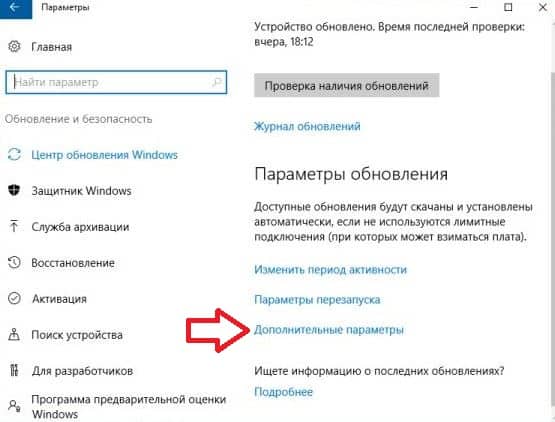
4. Uncheck "When I update Windows, provide updates for other Microsoft products."
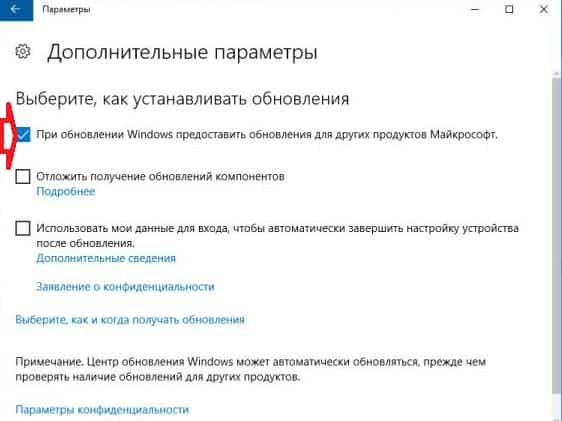

5. Start searching for and installing updates again; when the updates are found and installed, you can return the checkbox and try running the updates again.

Fix Windows Update by manually deleting cache Windows 7.8 or 10
We clear the cache using one of the methods below; if the first method does not work, try the next one.
1.Click on the taskbar with the right mouse button and select “Task Manager”. In the window that opens, select the "Services" tab and look for wuauserv(Windows Update) => right-click on this service and select “Stop”;
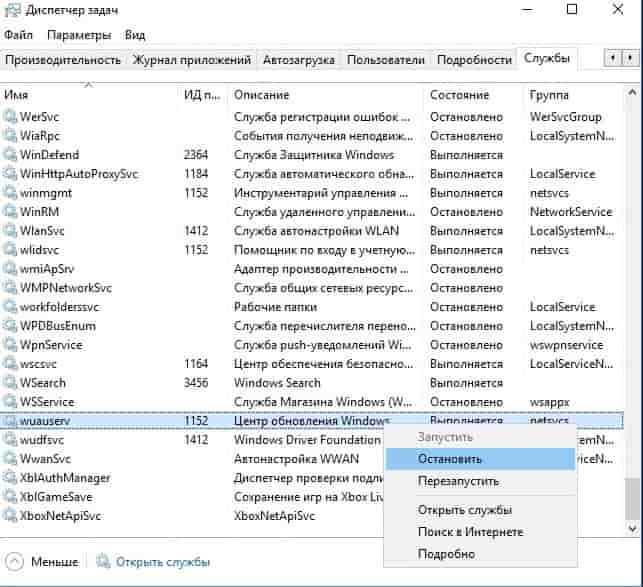
Now open Explorer and go to the C:\Windows\SoftwareDistribution folder. You need to delete everything from this folder, don’t be afraid to delete, there’s nothing important there. Updates are downloaded to this folder before installation.
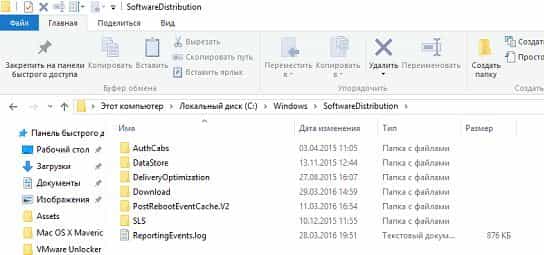
After deleting the folders, start the update service again: go to the task manager (by right-clicking on the taskbar and selecting it from the list) => services => to wuauserv Right-click and select "Run".
2. The second way to stop the service and delete the cache: click on “Start” with the right mouse button and select “ “ => write the command net stop wuauserv and press Enter

Write a command
net stop bits and press Enter => write the command
del c:\windows\SoftwareDistribution /q /s and press Enter again => run the command
net start wuauserv and press Enter.
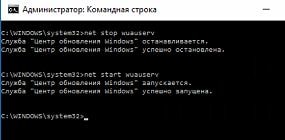
Write a command net start bits and press Enter, then close command line.
Now we try again to download and install updates, although most likely the system itself is already doing this. These methods should fix update installation errors in Windows Update.
WSUS Offline UpdateIf the solutions above do not solve your update problems, use a third-party tool called WSUS Offline Update.
This tool will download available updates Windows from Microsoft and will install them. By updating in this way once, all future updates via Windows Update will be installed without problems.
If you are wondering how to install Windows 10 via Update, then we, unfortunately, have to disappoint you - at this moment this is impossible - the shop was closed on July 29, 2016. While other users are doing their best to pervert and download the new “ten” from torrents (at the same time stuffing their computer with various rubbish from crooked “assemblies”), adequate and experienced PC users understand perfectly well that no one updates better than the operating system manufacturer will produce.
We will tell you about quite official way, thanks to which you can update your top ten, but this can be done not through the update center, but in a slightly different way. Microsoft recently gave access to upgrading to Windows 10 to people who need special abilities(virtual magnifying glass, keyboard, etc.). This version in fact, it is no different from a regular one, it just has additional devices that do not need to be turned on (after installation they are in the off mode).
You need to go to the following page of the official Microsoft website. You will see the following:
- Click "Update Now";
- Wait for it to download installation file(will appear on the desktop);
- Two clicks on the file - follow the instructions (you will need to reboot at the end).
That's it, now you have ten installed. If anything remains unclear, watch the video:
The bottom line is, if you were looking for the answer to the question “how to install Windows 10 through Update Center,” the answer is no way. Now you can purchase ten either for money (buy a license) or use the instructions described above (until this method is closed).
Below are instructions on how you could update Windows 10 through the update center, which was valid until July 29, 2016. All that remains is to remember how it was before.
How was it possible to update to Windows 10 earlier (via Update)?
Previously, everything was easier, you could get Russian Windows version 10 via update center.
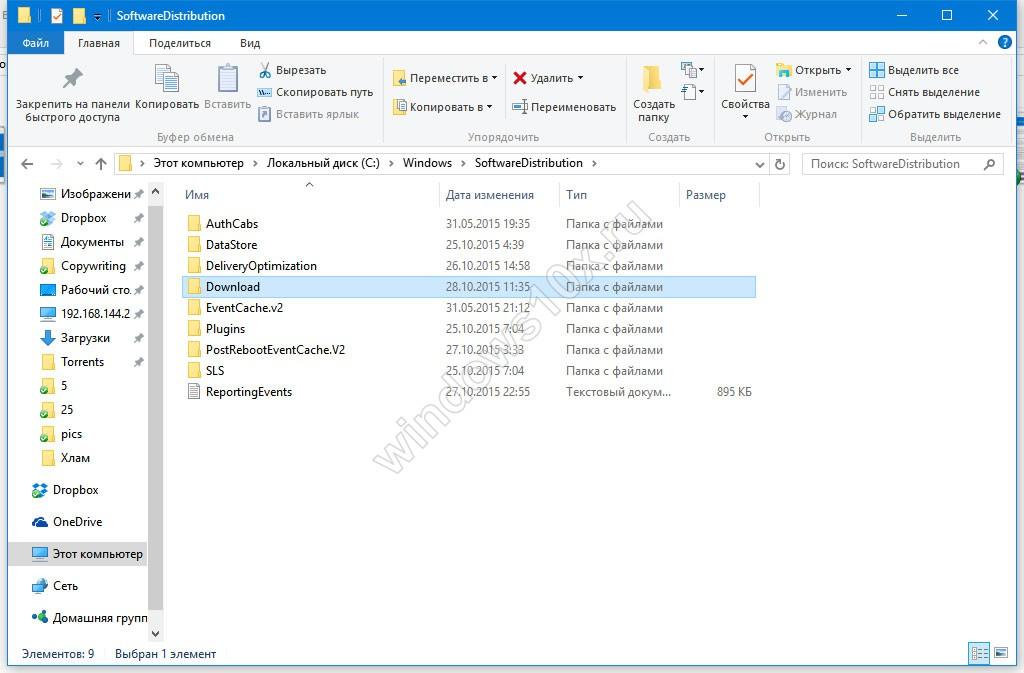
This is how easy it was to install Windows 10 through Update Center. Many, unfortunately, missed this moment and are now biting their elbows. Remember that it is quite normal if you are not currently updating/installing Windows 10 through the update center! This cannot be done after 07/29/2016. You can either purchase a paid version, or use the instructions that we gave at the beginning of the article to become the owner of a free ten.
Also, you can use our instructions, in which we described - this option is perfect for those who want to install a new operating system “here and now”.
Be that as it may, we can only congratulate you on the fact that you decided to take a step forward and not remain with obsolete software in the form of “seven”, “eight” or even, what the hell, Windows XP. The latest edition of Microsoft's most popular OS, which is so easy to install, has a huge number of innovations, and the store has also been significantly improved, thanks to which you have the opportunity to use many useful programs and interesting games absolutely free!
Appearance new Windows aroused the interest of many users. There were many rumors about the features and differences from previous versions. And of course, many people want to test the new system, especially since it is distributed free of charge for a year after its release.
Also, installation through the Update Center does not require any special knowledge, it is fast and does not delete the user’s personal data, which is very convenient. In addition, you can download the system image and install it on any computer.
Installation via Update Center
Many users receive a message that suggests trying to install a new system. Also in Windows 8.1, a button appeared in the tray, by clicking on which you can start installing windows 10.
And so, to update the system, you need to go to the Update Center through the control panel. Click on “Update” and wait about half an hour until the necessary files are downloaded.
 If you have it disabled on your computer automatic update, then you will first have to install them all and only then will the message about changing Windows. Also, if you have Windows 8, you will have to update it to Windows 8.1, and only then install version 10. For the seven there are no restrictions other than assembly. If you had Windows 7 Home, Windows 10 will also be Home.
If you have it disabled on your computer automatic update, then you will first have to install them all and only then will the message about changing Windows. Also, if you have Windows 8, you will have to update it to Windows 8.1, and only then install version 10. For the seven there are no restrictions other than assembly. If you had Windows 7 Home, Windows 10 will also be Home.
In order for the installation to go smoothly, be sure to ensure that the Internet connection is stable and preferably at high speed.
After the system boots, a window will appear in which you need to confirm your desire. If you change your mind about changing the system, then at this stage you can refuse without loss.
After agreeing, another window will appear where you need to read and agree to the license agreement. Next, the system will check if your computer is suitable for .
 Finally, a final window will open asking you to install the update now or do it after some time. At this stage, check that all important documents are closed so as not to lose them. If something needs to be completed, postpone the download, but if everything is fine, then select installation now.
Finally, a final window will open asking you to install the update now or do it after some time. At this stage, check that all important documents are closed so as not to lose them. If something needs to be completed, postpone the download, but if everything is fine, then select installation now.
After all these manipulations, the computer will reboot, the installation will continue and you will have to wait again for a certain amount of time. The last step is to select settings, but as a rule they do not need to be changed.
 All programs, user files and settings remain unchanged and are transferred to the new operating system.
All programs, user files and settings remain unchanged and are transferred to the new operating system.
Updating via Update Center is not available on Windows xp, Vista and Windows 7 without Service Pack 1 installed. Owners of these systems can only get system 10 by downloading the image from the official website and installing it manually.
Windows 10 system requirements
If the computer works normally with Windows 8.1, then the tenth version will install normally and will be operational. But in any case, you need to check your device for compliance with the minimum requirements:
- The processor must have a frequency of 1 GHz or higher;
- RAM must be more than 1 GB;
- Availability of free memory 16 GB;
- Video card: DirectX 9 compatible with WDDM support;
Also check system requirements for compliance you can use special utility from Microsoft, if it shows that installing Windows 10 is impossible, it will tell you the reason.
Windows 10 activation
After updating Windows 7 and 8.1 via Update, the installer checks that the system is licensed and activated. The user is not given any keys; the computer is registered on Microsoft servers.
The system is activated without user intervention if the data on the servers matches. If the system has not been updated, registration will not take place. Also, keys from Windows 7 and 8.1 are not suitable for activation.
That's why the update pirated versions impossible. That is, of course you can install Windows 10, but after a while it will stop receiving updates and will constantly remind you of the need to purchase a license.
Errors during update
There are often cases when, during an update, the system produces errors that prevent the new OS from installing correctly or simply cancel the installation. If this happens through the Update Center, then the easiest way is to download the image from the site and install Windows from removable media. But with this method you will have to erase all information from the computer.
After the update, the sound may disappear. It's all about the audio device driver. Either he did not have time to update his software to work on Windows 10, or it works, but not correctly. Here you can update it or remove it completely and install it again. It may also be that the device is so old that its support has ended and drivers for Windows 10 simply do not exist.
If error 80240020 appears in the installation log, then you need to go to C:\Windows\SoftwareDistribution\Download and delete everything that is there. Next, launch the command line and write wuauclt.exe /updatenow .
One of the common problems among Windows 10 users is the stopping or inability to download updates through the update center. However, the problem was also present in previous versions of the OS, as described in the instructions.
Windows Update Troubleshooting Utility
The first action that makes sense to try is to use the official utility to troubleshoot problems when downloading Windows 10 updates, and, apparently, it has become more effective than in previous versions of the OS.
You can find it in “Control Panel” - “Troubleshooting” (or “Find and fix problems” if you are viewing the control panel in categories).
At the bottom of the window, under System and Security, select Troubleshoot using Windows Update.

A utility will launch to find and fix problems that interfere with downloading and installing updates; all you have to do is click the “Next” button. Some fixes will be applied automatically, some will require the “Apply this fix” confirmation, as in the screenshot below.

After the scan is completed, you will see a report on what problems were found, what was fixed, and what could not be fixed. Close the utility window, restart your computer and check if the updates are downloading.

Additionally: In the Troubleshooting section, under All Categories, there is also a troubleshooting utility called BITS Background Intelligent Transfer Service. Try starting it as well, since if this service fails, problems with downloading updates may also occur.
Manually clearing Windows 10 update cache
Although the troubleshooting utility also tries to perform the steps described below, it does not always succeed. In this case, you can try clearing the update cache yourself.
- Disconnect from the Internet.
- Run Command Prompt as an administrator (you can start typing “Command Prompt” in the taskbar search, then right-click on the result found and select “Run as administrator”). And enter the following commands in order.
- net stop wuauserv(if you see a message that the service could not be stopped, try restarting your computer and running the command again)
- net stop bits
- After that, go to the folder C:\Windows\SoftwareDistribution\ and clear its contents. Then go back to the Command Prompt and enter the following two commands in order.
- net start bits
- net start wuauserv
Close Command Prompt and try downloading updates again (remembering to reconnect to the Internet) using Windows 10 Update. Note: After these steps, shutting down your computer or restarting it may take longer than usual.
How to download Windows 10 offline updates for installation
It is also possible to download updates not using the update center, but manually - from the update catalog on the Microsoft website or using third party utilities, such as Windows Update Minitool.
To access the Windows update catalog, open the page https://catalog.update.microsoft.com/ in Internet Explorer(you can launch Internet Explorer using the search bar Windows tasks 10). When you first log in, the browser will also offer to install the component necessary to work with the catalogue, agree.
After that, all that remains is to enter the number of the update you want to download into the search bar, click “Add” (updates without x64 are intended for x86 systems). After that, click “View cart” (to which you can add several updates).
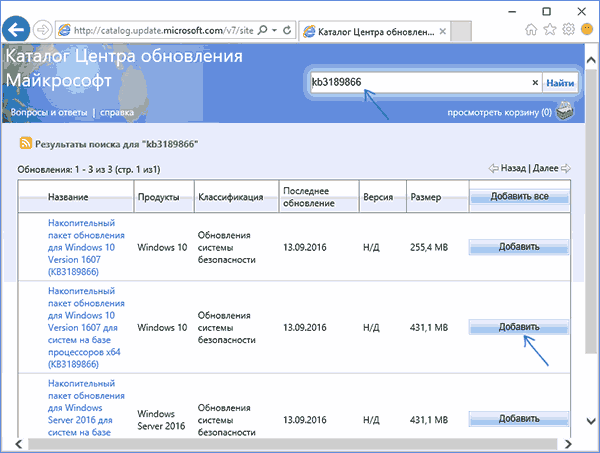
And finally, all you have to do is click “Download” and specify the folder to download updates, which can then be installed from this folder.

Another option to download Windows 10 updates is third party program Windows Update Minitool (the official location of the utility is the ru-board.com forum). The program does not require installation and uses Windows Update to operate, however, offering more advanced features.

After starting the program, click the “Update” button to download information about installed and available updates.
- Install selected updates
- Download updates
- And, interestingly, copy direct links to updates to the clipboard for subsequent simple downloading of .cab update files using a browser (a set of links is copied to the clipboard at once, so before entering it into the address bar of the browser, it’s worth pasting the addresses somewhere into the text document).
Thus, even if downloading updates is not possible using the Center mechanisms Windows updates 10, it is still possible to do this. Moreover, offline update installers downloaded in this way can also be used for installation on computers without Internet access (or with limited access).
Additional Information
In addition to the above points related to updates, pay attention to the following nuances:
- If you have a “Limited connection” Wi-Fi set (in the settings wireless network) or is using a 3G/LTE modem, this may cause problems downloading updates.
- If you are, then this could cause problems with downloading updates due to blocking of addresses from which downloads are made, for example, to.
- If you are using third party antivirus or firewall, try disabling them temporarily and check if the problem is resolved.
And finally, in theory, you could previously perform some actions from the article, which led to the situation with the impossibility of downloading them.
Before reading this material, we recommend that you read our guide to upgrading to Windows 10. This article was updated with the release of the final version of the operating system, the comments remain the same.
Windows Insider Program
After the failure with Windows 8, Microsoft company strives to regain the trust of users. Indeed, until now, despite the completion of the main stage of support for Windows 7, users prefer it to the modern “eight”. “Seven” remains the most popular desktop operating system to this day, and even the release of 8.1 with a more user-friendly interface did not change the balance of power.
Let us remind you that on January 13, 2015 the main Windows support 7. Extended support will be provided until January 14, 2020, but only for systems with Service Pack 1 installed (it is free). This means that Microsoft will no longer fix non-security-related errors in the operating system, but will continue to release patches to close security holes in the OS.
The failure of the G8 prompted developers to create the Windows Insider program, which anyone can take part in. Its main essence is that users voluntarily test the operating system being developed, leave reviews and comments on the operation of this or that functionality, and report what they like and what they don’t. This is done, for example, through Windows application Feedback, which is built into all preview versions of Windows 10. Currently, the number of participants in this program exceeds 2 million people who have left more than a million reviews. Here is an example of such a comment:
Today Microsoft released the publicly available final version of Windows 10 in Russian, and invited all users of previous operating systems to upgrade to it. Participants Windows programs Insider is updated to the final version as always by receiving the next update. Everything is simple here, whoever needs it knows and there is no point in talking about it.
And here ordinary users have two ways:
- Update through the Update Center, saving all your personal data, settings and some applications, having previously reserved the OS. We talked about how to reserve your copy in our migration guide;
- Download the official iso image and install Windows 10 from scratch. About installing tens bootable flash drive or disk, we won’t talk about it in this article either. Everything interesting, including the nuances of activation, is described in the link.
By the way, only owners of the “seven” and “eight” will be able to upgrade to the “ten” for FREE within the first year after its release.
The fact that the developers have implemented a system update via Windows Update is incredibly pleasing; it’s very convenient (about the features new system we have already written about updates in this article). We’ll talk about this below, but in a nutshell it goes like this:
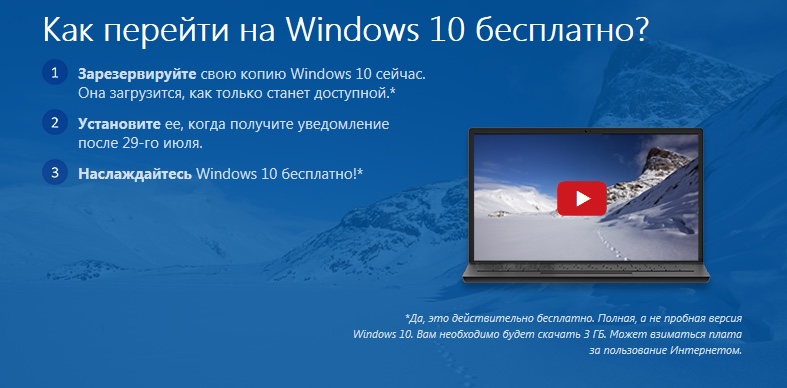
System requirements
Basically, if your computer works fine with 8.1, then you don't have to worry. In any case, when installing the update, the system will be checked for compliance with the minimum requirements:
- Processor: 1 GHz or higher;
- RAM: 1 GB (32-bit) or 2 GB (64-bit);
- Free hard disk space: 16 GB;
- Video card: DirectX 9 compatible with WDDM support;
- Account Microsoft and Internet access.
A few important notes:
- To access the App Store and download and run apps, you must be connected to the Internet and have a screen resolution of at least 1024x768 pixels;
- Windows 10 includes a new app store that has fewer apps and may not have your favorite one at all;
- If you have Windows 8 Professional edition with installed Windows Media Center, then after the update WMC will be deleted;
- After the update, you will not be able to play discs through standard Media Player;
- Windows 7 without Service Pack 1 installed cannot be upgraded to Windows 10 via Windows Update. Likewise Windows users RT, Vista and XP cannot update their systems; they will have to download the image and install the system from scratch;
- Likewise, 8.1 users can upgrade, but Windows 8 users cannot;
You can check the system for compliance using a small utility from Microsoft that backs up the system. If your system is not suitable, the program will tell you the reason. We talked about it in the second part of this article.
So, after you have reserved Windows 10 and if your system meets the necessary requirements, then you will see the following message in the Control Panel:

Let's leave 8.1 alone and update Service Pack 1 - the process is the same for both systems, but I'm more interested in doing this with the "seven". And considering how popular this operating system is, I’m not the only one.
Update process
If the update is reserved, but you still don’t receive a notification about the availability of Windows 10, then you just need to wait. Now many systems around the world are being updated, you need to wait your turn. The process runs at a speed of 16 updates per second. Of all the methods proposed in the comments to this article, this is the most correct.
Or do this: go to the C:\Windows\SoftwareDistribution\Download folder and delete all files and folders from there. After that, launch the command prompt and run the command wuauclt.exe /updatenow.

It was after this manipulation that the download started for me, since no message arrived. You can monitor the process in the update center (you may need to wait about 5 minutes before the bootloader starts launching). It is worth saying that the method with wuauclt.exe /updatenow works every now and then and not for everyone.
The only moment: if you have a $windows.~BT folder there that is about 6 gigabytes in size, then most likely it contains an already downloaded update. But you don’t receive a notification due to high load on Microsoft servers, you just need to wait. What's interesting is that when you try to run the setup.exe file from the $windows.~BT folder, the files are erased...
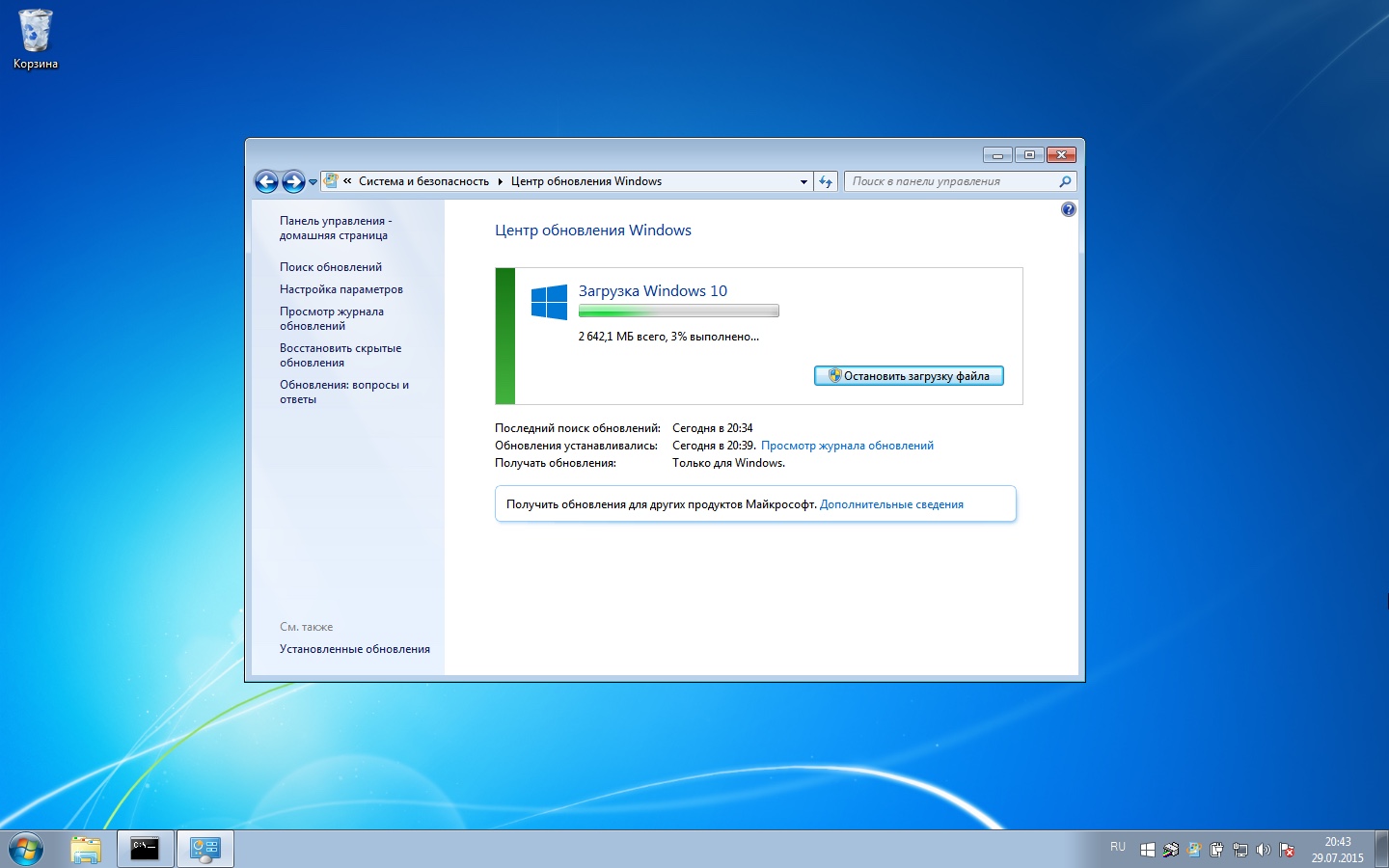
If you receive a notification about the availability of “ten”, then click the “Install” button. The 2,642.1 MB update will begin downloading. For me, the update took about 40 minutes to download, but you can wait longer due to the high load on Microsoft servers. Or less.
Once the download is complete, preparations begin for installing the operating system, which lasted about 10 minutes for me:
![]()
The installation ends with several dialogues: you will have to once again confirm your desire to update - here you can turn back if you suddenly change your mind. Next we accept license agreement and wait until the system is checked.
After this you will see latest instructions. Here you can postpone the update for a certain time or start installing Windows 10 right now. In any case, you will end up with the system rebooting for the update configuration (about 10 minutes).
After the reboot, the installation will continue and will take some time. It took me about 20 minutes. Once the installation is complete, preparations for launching the updated operating system will begin. Eventually, the black screen gives way to a greeting, after which you are asked to change a number of settings or leave the recommended ones.
I chose standard settings, the list does not need to be changed in 90% of cases. And now, the updated Windows 7 SP1 10 appears before us.
All mine installed programs remained, pictures, documents and system settings were safely transferred to the new operating system. In general, the transition from Windows 7 Service Pack 1 was successful! I haven’t tried it, but I think that in the case of 8.1 the update will be similar.
Rollback
If you do not like the new Microsoft development, then within 30 days from the date of update you can roll back to the previous version of Windows while saving all data. It’s important to remember here: if after switching to Ten you delete the C:\Windows.old folder, you won’t be able to go back.
Windows 10 activation
When you upgrade Windows 7 and 8.1, the installer checks to ensure that the older systems are licensed and activated. The user does not receive a key - instead, the user's computer with its unique combination of components is registered with Microsoft servers. When installing Windows 10 in the future on the same computer, a comparison will be made with data from the Microsoft server and if there is a match, the system will be activated automatically.
If you do not update first, this registration will not take place. Unable to enter Windows 7 or 8.1 key during the process Windows installations 10, there is also no web form where you can enter this key and get a key for Windows 10.
Errors during update
During the update process, you may receive various errors that prevent the update or simply cancel it. The easiest way is to install Windows 10 from a bootable USB flash drive/disk. Download the official image. There's just one problem - you won't be able to transfer your files, data and applications. Everything will have to be installed and configured again.
The following are currently known solutions to update errors. This list will be updated as effective ways to get rid of errors are discovered.
There is no sound, the keyboard does not work, etc.
There is only one reason - the driver of the corresponding device. Either the driver needs to be updated: with the release of Windows 10, manufacturers have updated drivers for their products, or it works with an error and needs to be reinstalled. There is a third option - your device is so old that its manufacturer did not release a driver for it under Windows 10.
Error 80240020
In this case, when viewing the update log, you may see the following entry: Upgrade to Windows 10 Pro Installation status: Failed. Error details: Code 80240020.
Error 80240020 can be treated quite simply. Go to the C:\Windows\SoftwareDistribution\Download folder and delete all files and folders from there. After that, launch the command prompt and run the command:
In the next 5 minutes, the download of the files necessary for the update will begin. You can monitor the process through Windows Update.
Error 80246007
If you receive error 80246007, it's worth checking that you have the Background Intelligent Transfer Service (BITS) service running. To do this, open the Start menu and go to Control Panel. In the search field, enter the word administration and select the "Administration" component from the search results.
Now double-click on Services and right-click on the Background Intelligent Transfer Service (BITS) service and go to Properties. On the General tab, the Startup Type group should be set to Automatic (Delayed Start). If this is not the case, then correct the situation and click “Apply”. Under Service Status, make sure the service is running. If it is not running, click the “Launch” button.




